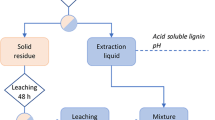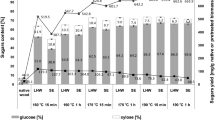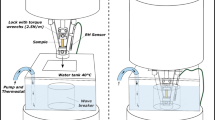Summary
The dissolution and dispersion of components from Norway spruce (Picea abies) wood were examined in laboratory experiments to determine the factors influencing variations in dissolved and colloidal substances in mechanical pulp suspensions. Finely ground, fresh spruce wood was suspended in water at 90 °C and was agitated intensively for up to 12 h, after which the concentrations of dissolved and dispersed lipophilic extractives, lignans, carbohydrates and lignins were determined. Sapwood and heartwood were studied separately. Effects of pH and added electrolytes on the dissolution and dispersion of wood components were also investigated.
Higher amounts of lipophilic extractives, and especially of triglycerides, were dispersed from sapwood than from heartwood. The release of lipophilic extractives continued for up to 3 h, after which the concentrations in the suspensions leveled off. At this stage the composition of the dissolved and dispersed lipophilic extractives equaled that of the wood. The amount of lipophilic extractives in the suspensions increased with increased pH, in the range of 4.5–6.7, but was lower in the presence of electrolytes. The dissolution of carbohydrates continued even beyond 3 h of agitation. The high water temperature induced hydrolytic reactions, thereby releasing especially arabinose. The release of arabinose through the hydrolytic cleavage from polysaccharides was more extensive at pH 4.5 than at pH 5.5 and 6.7. More polysaccharides containing galacturonic acid units (pectins) were dissolved at a higher pH. Much more polysaccharides containing glucose, most probably starch, were present in the sapwood suspensions. The dissolution of lignins also continued throughout the 12 h experiment. The measured UV-absorption, after extraction of lignans, was roughly the same for sapwood and heartwood suspensions. Slightly less lignins were released in the presence of electrolytes. Lignans were released only from heartwood.
Similar content being viewed by others
References
Alèn, R.; Jännäri, P.; Sjöström, E. 1985: Gas-liquid chromatographic determination of volatile fatty acids C1-C6, and lactic acid as their benzyl esters on a fused-silica capillary column. Finn. Chem. Lett.: 190–192
Aspinall, G. O. 1970: In: The Carbohydrates. W. Pigman, D. Horton, and A. Herp, Academic Press, New York
Auhorn, W.;Melzer, J. 1979: Untersuchung von Störsubstanzen in geschlossenen Kreislaufsystemen, Wochenbl. Papierfabr. 107: 493–502
Björklund-Jansson, M. 1978: Kemisk sammansättning hos avloppsvatten från mekanisk massatillverkning före och efter biologisk rening. Nordmiljö 80, Report 213:11, Stockholm (in Swedish)
Brandal, J.;Lindheim, A. 1996: The influence of extractives in groundwood pulp on fibre bonding. Pulp Pap. Can. 67: T431–435
Eckerman, C.;Ekman, R. 1990: Analys av kolhydrater i vattenfasen från suspensioner av mekaniska massor. Report 134-90, Dept. of Forest Products Chemistry. Åbo Acadmmi University, Turku/Abo, Finland (in Swedish)
Ekman, R. 1979: Distribution of lignans in Norway spruce. Acta Acad. Abo., Ser. B 39: 3, 6 p
Ekman, R.;Eckerman, C.;Holmbom, B. 1990: Studies on the behavior of extractives in mechanical pulp suspensions. Nord. Pulp Pap. Res. J. 5: 96–102
Ekman, R.;Holmbom, B. 1989: Analysis by gas chromatography of the wood extractives in pulp and water samples from mechanical pulping of spruce. Nord. Pulp Pap. Res. J. 4: 16–24
Ekman, R.;Peltonen, C.;Hirvonen, P.;Pensar, G.;von Weissenberg, K. 1979: Distribution and seasonal variation of extractives in Norway spruce. Acta Acad. Abo., Ser. B 39: 5, 26 p
Fengel, D.;Wegener, G. 1989: In: Wood — Chemistry, Ultrastructure, Reactions. de Gruyter, Berlin, New York
Gellerstedt, G.;Zhang, L. 1992: Formation and reactions of leucochromophoric structures in high yield pulping. J. Wood Chem. Technol. 12: 387–412
Holmbom, B.; Örså, F. 1993: Methods for analysis of dissolved and colloidal wood components in papermaking process waters and effluents. 7th Int. Symp. Wood Pulp. Chem. Proceedings, Vol. 2, Beijing, pp. 810–817
Lindström, T.;Söremark, C.;Westman, L. 1977: The influence on paper strength of dissolved and colloidal substances in the white water. Svensk Papperstidn. 80: 341–345
Linhart, F.;Auhorn, W. J.;Degen, H. G.;Lorz, R. 1987: “Anionic trash”: controlling detrimental substances. Tappi J. 70: 79–85
Nimz, H. 1974: Das Lignin der Buche — Entwurf eines Konstitutionsschemas. Angew. Chem. 86: 336–344
Örså, F.;Holmbom, B. 1994: A convenient method for the determination of wood extractives in papermaking process waters and effluents. J. Pulp. Pap. Sci. 20: J361–366
Pelton, R. H.;Allen, L. H.;Nugent, H. M. 1980: Factors affecting the effectiveness of some retention aids in newsprint pulp. Svensk Papperstidn. 83: 251–257
Pranovich, A. V.; Holmbom, B.; Sjöholm, R. 1994: Characterization of dissolved lignins in thermomechanical pulp suspensions. 3rd European Workshop of Lignocellulosies and Pulp Proceedings, Stockholm, pp. 219–222
Sjöström, J. 1990: In: Detrimental Substances in Pulp and Paper Production — Approaches to Chemical Analysis of Deposits and Dissolved Organic Matter. Ph.D. Thesis, Abo Akademi University, Turku/Åbo, Finland
Sjöström, J.;Reunanen, M. 1990: Characterization of lignin and carbohydrates dissolved in groundwood pulping by pyrolysis-gas chromatography-mass spectrometry. J. Anal. Appl. Pyrol. 17: 305–318
Sundberg, K.;Thornton, J.;Ekman, R.;Holmbom, B. 1994: Interactions between simple electrolytes and dissolved and colloidal substances in mechanical pulp. Nord. Pulp Pap. Res. J. 9: 125–128
Suckling, I. D.;Hua, H. L.;Uprichard, J. M. 1990: Factors affecting resin removal from radiata pine mechanical pulps. Appita 43: 217–221
Thornton, J. 1993: In: Dissolved and Colloidal Substances in the Production of Woodcontaining paper. Ph.D. Thesis, Åbo Akademi University, Turku/Åbo, Finland
Thornton, J.; Eckerman, C.; Ekman, R. 1991: Effects of peroxide bleaching of spruce TMP on dissolved and colloidal organic substances. 6th Int. Symp. Wood Pulp. Chem. Proceedings, Vol. 1, Melbourne, pp. 571–577
Wearing, J. T.;Barbe, M. C.;Ouchi, M. D. 1985: The effect of white-water contamination on newsprint properties. J. Pulp Pap. Sci. 11: J113–121
Author information
Authors and Affiliations
Rights and permissions
About this article
Cite this article
Örså, F., Holmbom, B. & Thornton, J. Dissolution and dispersion of spruce wood components into hot water. Wood Sci.Technol. 31, 279–290 (1997). https://doi.org/10.1007/BF00702615
Received:
Issue Date:
DOI: https://doi.org/10.1007/BF00702615




